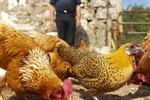
If you look closely, you'll see a bulge at the base of a chicken's neck just above her breast. It's her crop, and it's where food and water are stored when her digestive tract is busy processing previously consumed items. Although it's normal for a crop to be full at times, it can be dangerous to her health if it doesn't empty properly. A crop that's blocked with undigested food and water can become distended, so you'll physically see there is a problem. But you can catch crop issues early by examining your chicken's crop once or twice a week.
Step 1
Check your chicken's crop in the morning, before she eats, as her crop should be empty at that time of day. Steady the chicken with one hand and gently press on her crop with your fingertips.
Step 2
Interpret what you feel. A healthy empty crop will be firm but pliable. An impacted crop will feel hard because it is full of food. A sour crop will feel enlarged, like a water balloon, and will feel mushy. "Chicken Health for Dummies" by Julie Gauthier D.V.M. and Rob Ludlow says that with a sour crop you may also notice an unpleasant smell coming from the chicken's mouth.
Step 3
Empty your chicken's crop if it is full in the morning. Do this by tipping your chicken forward and massaging the crop, guiding the contents out. In the February/March 2013 issue of "Backyard Poultry" magazine, Ron Kean, extension poultry specialist at the University of Wisconsin-Madison, notes that emptying your chicken's crop for her is only a temporary solution. You should have the avian vet examine her to determine what is keeping her crop from emptying properly.
References
- Backyard Poultry Magazine, February/March 2013: Pendulous Crop
- University of Kentucky College of Agriculture: Poultry Production Manual
- Chicken Health for Dummies: Julie Gauthier, D.V.M. and Rob Ludlow
Tips
- The grass in your chickens' foraging area should be kept mowed short to ensure that any grass they eat won't be too cumbersome to pass through their crops.
- Always provide fresh, clean water, and try to keep it from becoming too hot during summer months. Chickens don't like to drink warm water -- they will sometimes go an entire day without drinking, then gorge themselves on it at night after it's cooled off. This can cause their crops to stretch out permanently. Keep it covered, and change it for cooler water frequently on hot days.
- Keep your chickens' pen and foraging area free from small metal and plastic objects. Swallowing them can cause problems in the crop and digestive tract in general.
Photo Credits
-
George Doyle/Stockbyte/Getty Images
Writer Bio
Elle Di Jensen has been a writer and editor since 1990. She began working in the fitness industry in 1987, and her experience includes editing and publishing a workout manual. She has an extended family of pets, including special needs animals. Jensen attended Idaho and Boise State Universities. Her work has appeared in various print and online publications.




